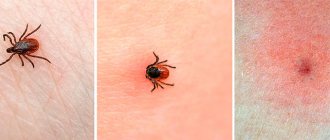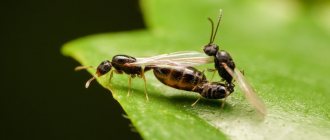Pollock, which in Soviet times had a firmly established reputation as “food for cats,” today is becoming more and more firmly part of the diet of the average resident of the post-Soviet space every day, which is explained by the low price of this fish against the backdrop of the economic crisis. This seemingly positive trend carries a hidden danger, since pollock ranks among the first among marine fish in terms of the degree of parasite infestation. In this article, we intend to understand what types of worms parasitize representatives of this type of fish, how dangerous the worms in pollock are to humans, and whether it is permissible to eat fish infected with them.
Are there worms in pollock?
Parasites are more common in pollock compared to other types of marine fish. According to statistics, more than 90% of the pollock catch is infected. The number of varieties of parasitic individuals found in this fish is very large.
Not all parasites in pollock pose a threat to human health. The most dangerous to humans are presented below.
Helminths in fish: what they are and why they are dangerous to humans
Fish is an essential food product in the human diet, but it is not always possible to purchase a high-quality product that will meet all requirements and sanitary standards. Recent studies show that any fish, both sea and river, can be wormed, and parasites pose a huge danger and threat to human life.
Very often, tapeworms - cystodes, roundworms - nematodes and flatworms - trematodes are found in fish. Some of them are absolutely safe, that is, they do not parasitize the human body, but some species pose a huge threat.
Roundworms (nematodes)
Pollock is an intermediate link in the life cycle of the anisakid parasite. Fish become infected with the larvae of this type of roundworm by consuming crustaceans. A person is a random link in the general chain of development of a larva into an adult - a nematode.
Infection with anisakids occurs when eating raw fish that has not passed sanitary control.
Pollock can be infected with larvae:
Complications of anisakidosis
Anisakid larvae are not able to develop in the human body into a sexually mature worm, but in the course of their life activity they provoke an acute allergic reaction in most people, intoxication of the body with signs of poisoning - anisakidosis.
Anisakids are the cause of:
Prevention and precautions
To avoid becoming a victim of helminthiasis, you must follow a few simple rules.
By taking simple precautions you can reduce the risk of parasite infection.
- Avoid sushi, as raw fish is used to prepare it.
- Don't be lazy and control the cooking time of fish dishes. Remember that heat treatment should take at least 20 minutes.
- Salt fish at recommended salt levels. This is 150 grams of salt per 1 kg of fish. Salting time is at least 3 days.
- Also, compliance with personal hygiene standards is not canceled.
- For owners of their own homes, it is necessary to calculate and install toilets with cleaning facilities.
- The state should not weaken control in the field of parasitic diseases.
- Educational activities play a huge role in the fight against helminths.
- Fish of the sturgeon family are least susceptible to helminthiasis. Carp, pike and pike perch are most often infected with worms.
- You should not eat river fish.
- If the fish you purchase contains a LIVE parasite, then such fish must be destroyed by fire.
- Eat pumpkin seeds, garlic and onions - this will help in the fight against helminths.
Follow these recommendations, treat it properly, and then not a single parasite will be dangerous to you!
Flatworms
This class of parasites is the most dangerous for humans. Infestations by flatworms are the most common.
Tapeworms
Cases of pollock infection with plerocircodial tapeworms cannot be ruled out. Most often this is:
Complications of invasion
Tapeworm causes taeniasis in humans, characterized by the following symptoms:
Wide tapeworm is the cause of the development of diphyllobothriasis, characterized by such symptoms as:
Flukes
Pollock is also a carrier of worm larvae - flukes. Dangerous to humans are:
Complications of flatworm infection
Infection of a person with metagonimus is called metagonimiasis in medical practice.
The disease is accompanied by:
The Chinese fluke is the causative agent of clonorchiasis.
The disease is recognized by symptoms such as:
Siberian fluke, the causative agent of opisthorchiasis.
The disease provokes the development of:
Safe parasites
It is worth noting that not all worms pose a danger to human health. Moreover, a large amount of fish comes to us already frozen, and the worms die at a temperature of -15-20 degrees in a few days (usually about a week). Moreover, with proper heat treatment, helminths also die, so the risk of infection is minimized. The following types of worms that are safe for humans include:
- all flatworms are diplostoma;
- round – saw-meters;
- some types of tapeworms.
Diplastorms and pilometers parasitize only fish; moreover, these worms parasitize the lens of the eyes and scales, therefore, with proper processing of the carcass, the adult larvae are removed before cooking. Cestodes are tapeworms, and not all of them are dangerous to humans. There are two known species that parasitize fish - the common Ligulidae and Schistocephalus solidus are small in size and parasitize only small fish.
How to recognize helminths in frozen pollock?
When purchasing frozen fish at the market or in a supermarket, the buyer does not have the opportunity to fully inspect the carcasses.
The presence of worms or their larvae in fish meat can be detected only after it has been defrosted.
Worms in frozen pollock are a phenomenon of poor sanitary control. Such products are not suitable for consumption. Despite evidence that the larvae and worms in pollock die when deep frozen, not all trading enterprises in the fishing industry today responsibly comply with the standards for the technological processing of fish raw materials. If numerous worm larvae are found in fish, the raw materials must be disposed of.
It should be noted that worms in frozen fish are not as dangerous as in freshly caught fish. Therefore, many fishing enterprises freeze catches with an acceptable level of parasite infestation and then send them for processing (salting, canning, smoking, pickling).
In what form should pollock be eaten?
A timely question arises: in what form can pollock be eaten? The abundance of fish products and delicacies on the shelves in hypermarkets seems to fascinate the consumer. Fish is on the shelves in fresh, frozen and canned form. So what kind of fish can you eat without becoming infected with helminths?
Eating raw fish is definitely strictly prohibited!
Even if it is marine, helminths and their larvae can live in it. Fresh fish must be carefully examined at home, the entrails removed and rinsed well. After this, the fish must be thermally treated. This contributes to the death of all parasites in it. The cooking method can be any, but process for at least 20 minutes at high temperatures. Boil, fry or bake pollock in the oven. It is not forbidden to salt fish. With the correct proportions of salt and fish, helminths in pollock also die. Frozen pollock is also safe.
Frozen fish is no longer so dangerous
At a temperature of -10°C, helminths die. They are sensitive to negative temperatures. But remember that pollock cannot be frozen and thawed several times. When shock freezing occurs, the quality of pollock does not deteriorate. If you find a helminth in frozen pollock, you can safely remove it and cook the fish undisturbed. In this case, technologists say: “A frozen enemy is a dead enemy”!
Canned or salted pollock is 50/50 safe. With the correct proportions of preservatives, including salt, the parasites die. But again, you should wait a certain time for preservation or salting, from 3 to 5 days. Salt is used in the amount of 150 grams per 1 kg of pollock.
What helminths can parasitize pollock and are there dangerous ones among them?
Pollock with worms is indeed not uncommon: for example, according to a 1997 study, 34% of individuals of this fish species are infected with anisakids - roundworms (nematodes) dangerous to humans from the Anisakidae family. In this regard, only silver hake (53% of the population is infected with anisakids), Japanese mackerel (100%) and Pacific herring (100%) can compete with it.
Despite the fact that anisakidosis was described in fish back in the 13th century, in marine mammals in the 18th century, and the first case of human infection was recorded in 1867, anisakidosis is a fairly new problem in parasitology. The ability of the larvae of these helminths to infect humans was only reliably established in 1955, when a resident of the Netherlands went to the hospital after eating lightly salted herring. It was then that the disease got its name - anisakiasis, and parasitologists and doctors paid attention to this helminth.
The mechanism of development of symptoms and possible complications of anisakidosis are a topic for a separate article, but it is enough to know that anisakidosis most often settles in the wall of the stomach, an organ protected from any other parasites. Although anisakid larvae are not able to develop into adults in the human body and live from several weeks to 3 months, during this time they can provoke perforation of the intestinal wall and cause peritonitis. In rare cases, anisacidosis even ends in death.
Anisakids are not the only worms dangerous to humans that use pollock as an intermediate or definitive host.
It has been established that pollock can be a carrier of acanthocephalan larvae Corynosoma strumosum, which are capable of living in the human body.
This concludes the list of pollock parasites that pose a danger to humans. In total, exactly 100 species of parasites were found in representatives of this species of fish, including:
- tapeworms - 19 species;
- digenetic flukes - 32;
- monogenetic flukes - 3;
- roundworms - 11;
- spiny-headed worms (acanthocephalans) - 13;
- annelids - 1;
- microsporidia - 1;
- myxosporidium - 6;
- Sporozoans - 1;
- ciliates - 1;
- crustaceans -12.
The information flashing in some Internet articles that pollock can be infected with the larvae of Siberian flukes, which cause opisthorchiasis in humans, is just an example of ignorance. Siberian flukes (opisthorchid) are capable of infecting only freshwater fish of the carp family.
The most dangerous parasites in sea and river fish
- Why is fish infected with parasites dangerous?
- How to distinguish infected fish?
- What to do if there are worms in the fish
- Which fish has no parasites?
There are many ways to become infected with parasites. One of the main ones is eating fish that has not undergone sufficient heat treatment. Parasites in fish are common: statistics say that approximately 90% of all fish living in fresh and sea water are affected by worms. Fans of dried, salted, smoked fish, as well as sushi and sashimi should know about this. Let's consider how dangerous fish worms are for people and what to do if the fish is infected.
Why is fish infected with parasites dangerous?
The main danger of fish infected with worms is that the worms living in the fish enter the human body and provoke the development of helminthiasis. Not all worms that infect fish can infect people. But it is important to realize which parasites are dangerous to humans, and in which types of fish they live. This will minimize the risk of invasion.
What worms in fish pose a danger to people:
- Tapeworm (tapeworm) – provokes the development of the disease diphyllobothriasis. It grows up to 12 m and lives in the human body for decades. This type of tapeworm affects pike, ruffe, perch, burbot, pike perch, and is sometimes found in salmon. Its larvae are quite large and white. They reach 5 mm in length and 3 mm in width. They are found in the muscles of fish, as well as in the internal organs. The number of larvae is very large, so they are easy to notice in raw fish during cutting.
- Fluke (feline and also Siberian) – provokes the development of opisthorchiasis. This parasite is relatively small in size - 8–13 mm, and affects the liver, gall bladder, its ducts, and pancreas. You can become infected by eating fish belonging to the carp family. This group includes rudd and carp, bream and roach, ide and dace, aspirant and tench. The danger is that fluke larvae are very small. A fish may look healthy, but its flesh contains thousands of parasite eggs.
- Trematodes are worms in fish that provoke the development of diseases such as nanophyetosis and metagonimiasis. The name of the fish in which trematodes can live is whitefish, chum salmon, Amur grayling, as well as malma, lenok, taimen, trout, Amur bream, carp, crucian carp. These worms settle in the small intestine of a person, causing enormous harm to health.
- Anisakides – provoke the development of anisakidosis. These worms live in sea fish: herring, cod, salmon, and sea bass. In the body of the fish, these helminths curl into a spiral. You can see what it looks like in the photo. Fans of Japanese cuisine, whose menu includes many raw fish dishes, are especially at risk of becoming infected with this parasite. These worms infect the gastrointestinal tract, causing the development of ulcers and other diseases.
Also, parasites absorb the bulk of nutrients, which leads to depletion. This is especially dangerous for children. If they systematically do not receive enough vitamins, minerals and other beneficial substances, a lag in physical and mental development may begin. Given such harmful consequences, it is important to avoid eating fish affected by helminths.
How to distinguish infected fish?
There are times when worms in fish are easy to detect. During cutting, mature individuals or large larvae are visible to the naked eye. In such situations, there is no doubt that the fish is infected.
The appearance of the fish may indicate helminth infestation. If there are black spots on its surface, then this is a clear sign of infection. This description is especially typical for herring.
Fishermen may also suspect that parasites live in fish while fishing. Such individuals have a special behavior - they float on the surface of the water, are lethargic, and also have a swollen belly. When you press on the belly of such a fish, a worm may appear.
What to do if there are worms in the fish
Worms can be found in river and sea fish, in particular in red fish. If you find them, it is better not to use such a product. It is especially dangerous to eat fish with tapeworm.
If you suspect that the fish is contaminated and you plan to eat it, you should follow the following rules:
- worms and their larvae die at high temperatures, so it must be boiled and fried for at least 20 minutes, and baked in the oven for at least 30 minutes;
- in salted fish, parasites die within 14–16 days;
- in frozen fish, parasites also die - when frozen at a temperature of -30 ° C, it is disinfected in 6 hours, -20 ° C in 36 hours, and -12 ° C in 60 hours.
Is it possible to eat fish with worms?
If worms are found in fish, it must be specially treated or destroyed. If you bought fish and found worms in it, then it must be frozen for at least two weeks and then properly thermally treated. In any case, well-cooked and fried fish will be absolutely safe for human health. You can eat fish with worms, but only after proper treatment and removal of the worms, if this does not cause disgust. If there are too many worms, it is better to throw away the fish and not even feed it to your cat.
It is impossible to say for sure whether it is possible to eat fish with worms. Not even all experts can give an accurate answer. The best way to take preventative measures is to never eat raw or lightly salted fish. In such conditions, there are all risks of infection. If you still cannot avoid the temptation, then it is best to eat only artificially grown fish.
Is it harmful to eat herring with worms? Well-salted fish does not contain dangerous worms; they simply die. To insure yourself against unpredictable situations, choose the right products - look at the eyes of the fish. If they fall out or become cloudy, refuse to purchase. Try to buy food only from trusted retail outlets that undergo sanitary control. This way you can avoid many problems.
Sea fish that has not undergone sufficient heat treatment can cause helminth infection. The infected fish are often low-grade fish, which is pollock.
Prevention of infection
Larvae or worms found in fish immediately suggest that contaminated fish products may have been previously consumed.
In order to protect your loved ones and yourself from unpleasant consequences, it is recommended to follow simple measures:
- It is not recommended to consume dishes with raw fish - these are rolls and sushi;
- It is not recommended to consume lightly marinated products, as well as cold smoked sea fish;
- it takes at least half an hour to cook and fry a raw or freshly frozen product;
- observe the rules of personal hygiene;
- If parasites are found in fish, it is recommended to stop eating it.
If you suspect that you have eaten contaminated fish, you should take an antiparasitic medication within a few hours afterward. Despite the fact that sea fish can be dangerous, it is certainly necessary to eat it, because it is very important for the human body. In order to protect yourself and your family, it is recommended to follow basic safety rules regarding the preparation of the product and its consumption.
Everyone who was born in the Soviet Union remembers that Thursday is fish day. Pensioners are nostalgic for the times when fish was prepared for visitors in canteens on Thursdays. The government introduced this measure to take care of the health of its citizens.
It is generally accepted that there are no helminths in marine fish. But studies conducted in 2007 proved that 40% of sea fish are affected by worms. The most affordable sea fish is pollock. Are there helminths in it? How dangerous is it for humans to eat fish infected with worms? Maybe it’s worth excluding fish products and delicacies from the menu and weekly diet? And what to do if you see worms in frozen pollock? You will find answers to these questions in our article.
Fish parasites dangerous to humans
Helminthiasis is a parasitic disease caused by helminths - parasites that affect all animals and humans. These parasites mainly live in the gastrointestinal tract. But some of them deposit cysts in the respiratory organs. By eating affected pollock that has not been thermally processed correctly, a person has every chance of acquiring worms. Helminths cause various and associated diseases, such as vitamin deficiency, anemia, allergic reactions and even intestinal obstruction, which can be fatal.
Parasites in pollock meat
Parasites such as helminths can be present in almost any type of fish, be it whiting, herring or pollock, and it is worth highlighting separately, since pollock is the most common and accessible fish among the Russian population.
Can helminths be found in pollock? Unfortunately, yes, because pollock is the same sea fish, although it is deep-sea and, according to statistics, every third individual has parasites inside.
If you try to compare pollock and some other seafood, its positive feature is its more affordable price, and in terms of the number of useful properties it is in no way inferior to other types of fish with a higher cost.
If you pay attention to the worms in pollock photos, which are not difficult to find, then seeing this, many may wonder what the likelihood of becoming infected with these parasites from frozen fish is, and what kind of parasites may be in it.
In fact, freezing can be different, and if the product has been subjected to shock freezing, then it becomes suitable for consumption, since almost all types of parasites die from exposure to low temperatures, but all the beneficial properties in the fish remain intact.
However, when purchasing fresh frozen pollock, you should be extremely careful and, after defrosting it, do not be too lazy to subject the fish to inspection.
If an examination of pollock reveals parasites, you must carefully:
- Clean all the insides.
- Rinse the fish under running water.
- How to heat when cooking.
You need to be afraid only of those parasites that turn out to be alive. Although, if the fish is cooked well and all the rules are followed, then it can be eaten.
But we should not forget that some types of parasites, when they find themselves in unfavorable conditions for them, form protective cysts, which are a kind of temporary form of existence for them.
Therefore, if live parasites are still found in pollock meat, you should not risk your own health and it is advisable to throw it out of the reach of pets, which, it is worth noting, when eaten, may also be infected and susceptible to negative effects.
What do worms look like in fish?
Worms or helminths are worms, so it is not difficult to visually identify them; they differ from each other in structure, shape and body size. It is worth noting that it is small worms and their larvae that are most dangerous to humans.
You can find worms with the naked eye, but they may not pose a particular danger to humans. A much more serious danger to humans is the larvae; they can only be seen in laboratory conditions using special equipment. Worms can also be found in salted fish, but it is not a fact that they will be alive. There can also be worms in frozen fish, but usually they die at a temperature of -20 degrees.
There are several varieties of worms that differ from each other and may look different in fish:
- The Amur fluke is a parasite of river fish, usually reaches no more than 1.5 cm in length, has a flat shape, and causes the disease opisthorchiasis in humans.
- Echinococcus is a tapeworm up to 0.5 cm long, does not cause disease, and can parasitize humans exclusively in an intermediate form.
- The broad tapeworm is a dangerous parasite for humans; it can reach a size of up to 12 m; most often, one or two individuals live with a person, no more.
- Trematodes - cause the disease metagonimiasis in humans, small worms measuring 2-2.5 cm.
- Nanophyetosis is a small parasite, its length is no more than 0.5 mm.
Sometimes the presence of worms in fish can be determined even without cutting the carcass, but by its appearance. Fish infected with parasites have cloudy eyes and their bodies are lined with small spines. Adults can be found when cutting fish. You can become infected with worms from fish in any form - from fresh, lightly salted and frozen, so be careful about the choice and processing rules.











